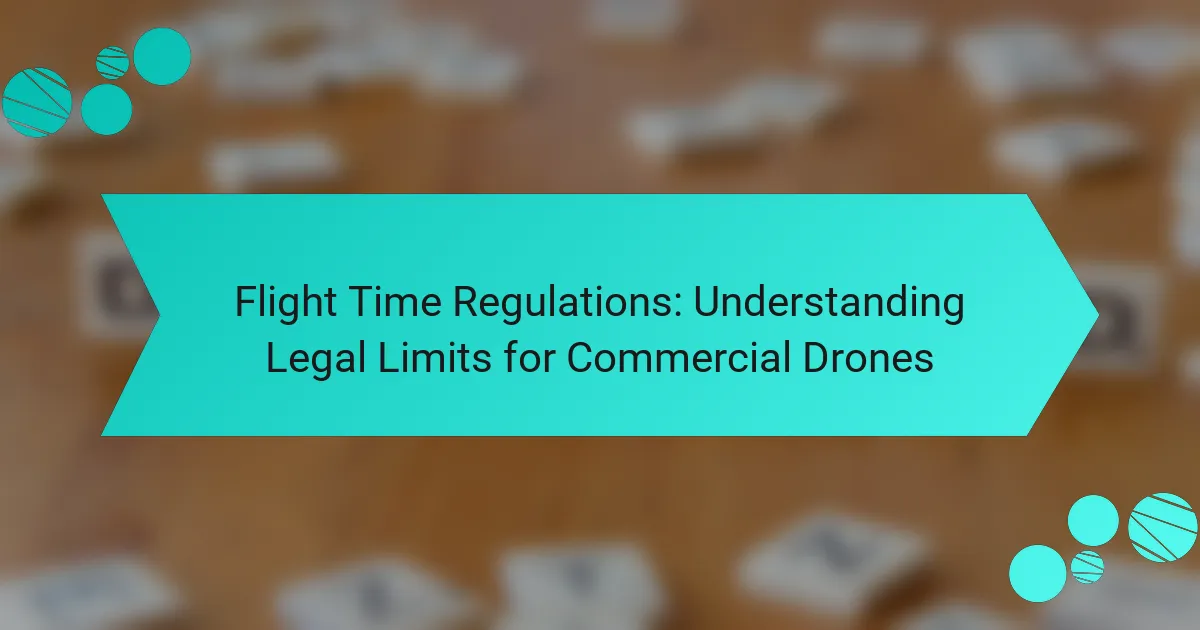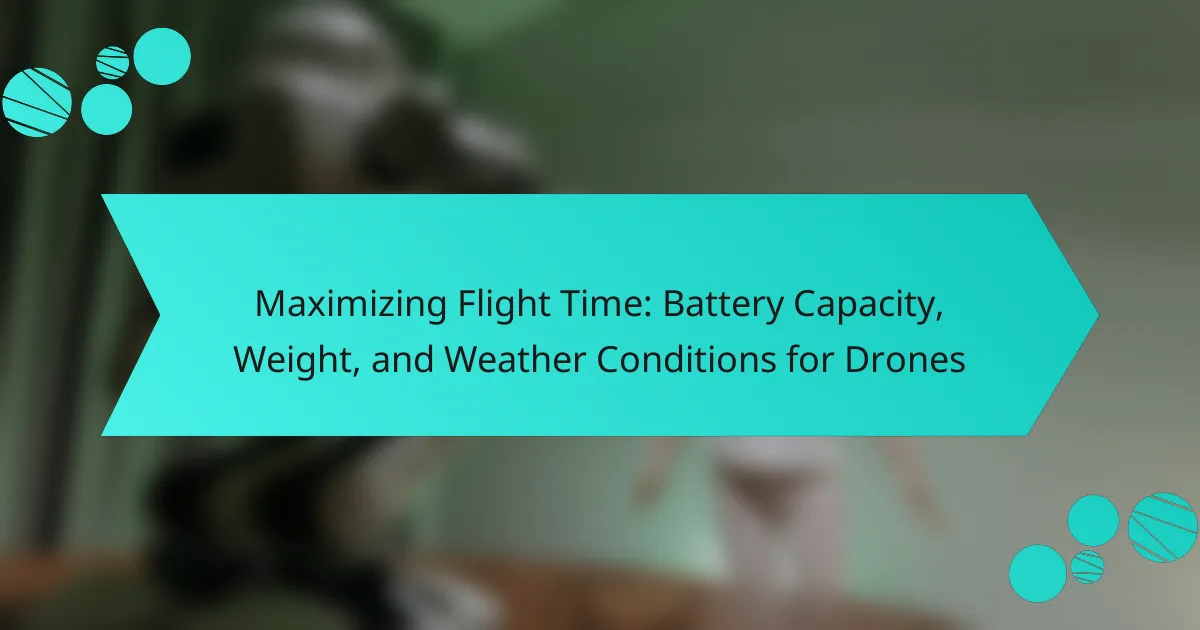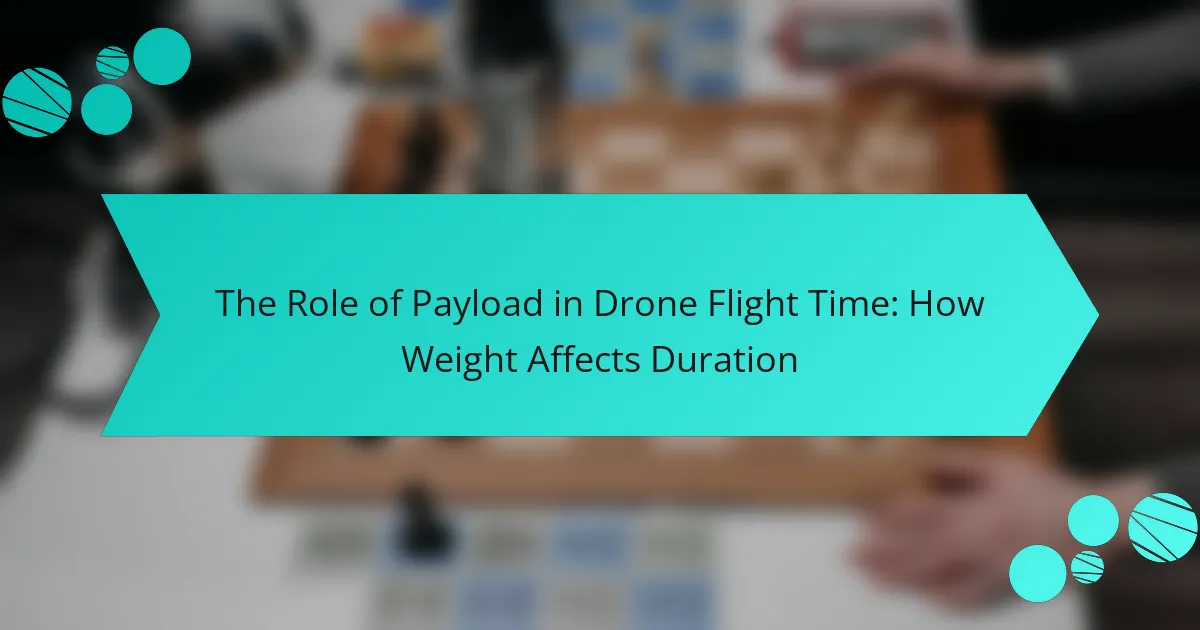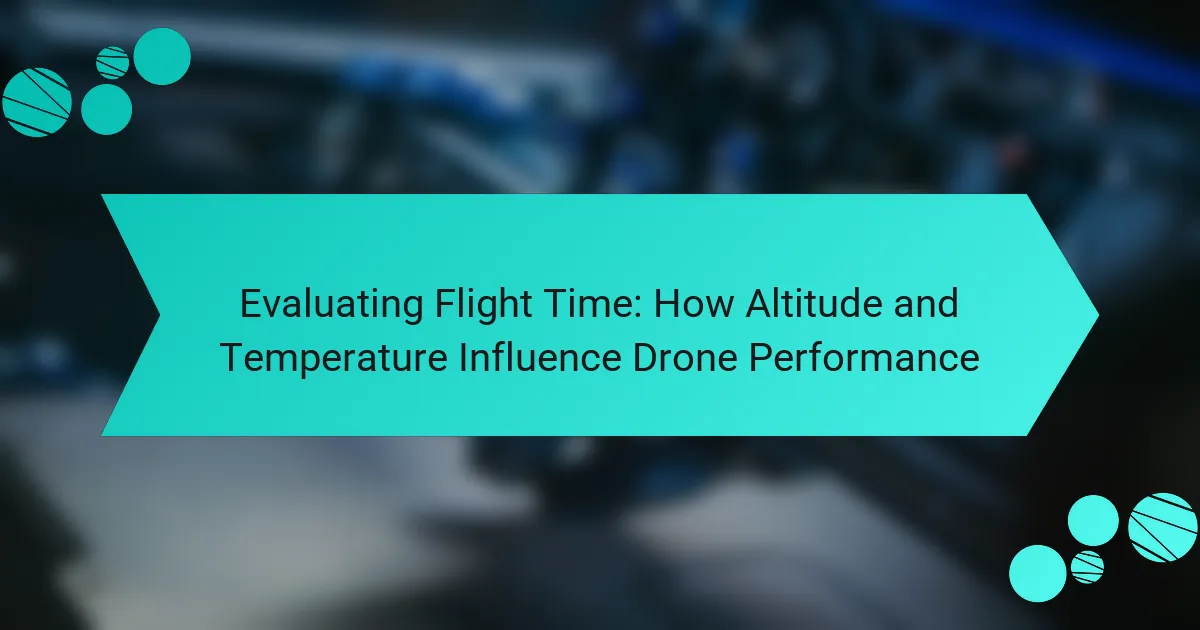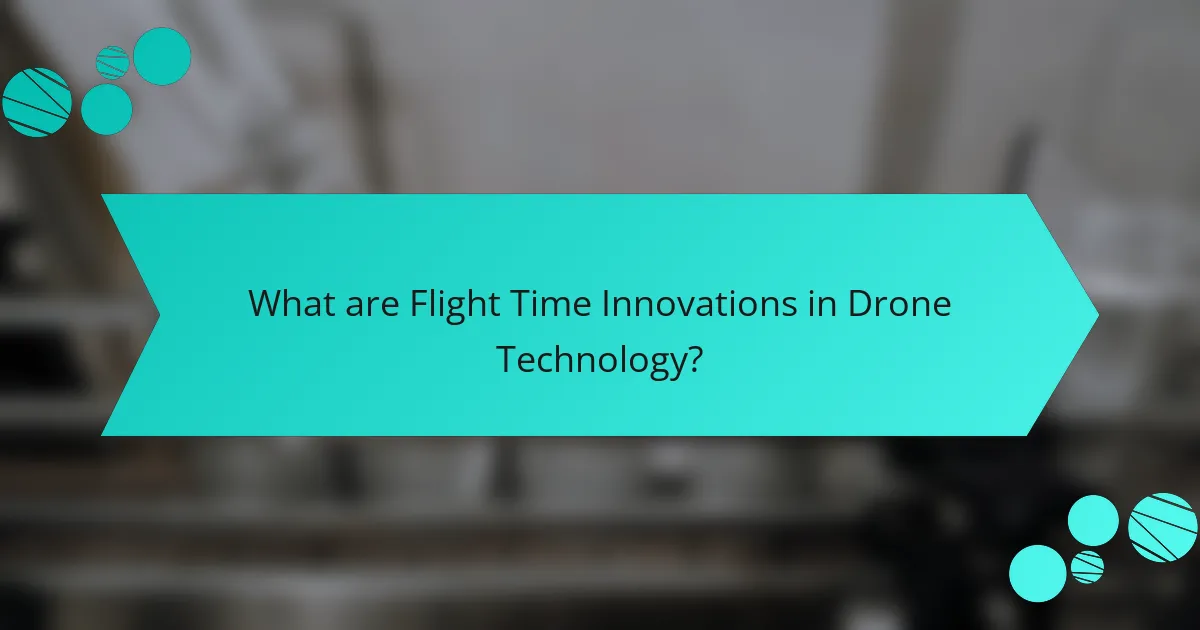
What are Flight Time Innovations in Drone Technology?
Flight time innovations in drone technology refer to advancements that extend the operational duration of drones. These innovations primarily stem from improvements in battery technology. New battery chemistries, such as lithium-sulfur and solid-state batteries, offer higher energy densities. For instance, lithium-sulfur batteries can potentially provide up to 500 Wh/kg compared to traditional lithium-ion batteries at 250 Wh/kg.
Additionally, advancements in energy management systems optimize power usage during flight. Enhanced propeller designs and lightweight materials also contribute to reduced energy consumption. Research indicates that these innovations can increase flight times by 50% or more.
Overall, flight time innovations significantly enhance the utility of drones across various applications, including delivery services and aerial surveying.
How do battery advancements impact drone flight times?
Battery advancements significantly enhance drone flight times. Improved energy density allows batteries to store more power without increasing size. For instance, lithium polymer batteries can provide higher capacity and lighter weight. This results in longer flight durations, often exceeding 30 minutes for consumer drones. Additionally, advancements in battery management systems optimize energy usage during flights. Enhanced charging technologies also reduce downtime between flights. As a result, drones can operate more efficiently, increasing their overall utility in various applications.
What types of batteries are currently used in drones?
Lithium polymer (LiPo) batteries are currently the most commonly used batteries in drones. These batteries offer a high energy-to-weight ratio, which is crucial for flight efficiency. LiPo batteries can deliver high discharge rates, allowing for rapid acceleration and maneuverability. Another type of battery used is lithium-ion (Li-ion) batteries. Li-ion batteries are known for their longevity and energy density. They are often used in larger drones due to their ability to store more energy. Additionally, some drones are experimenting with solid-state batteries. Solid-state batteries promise increased safety and energy density compared to traditional batteries. Research indicates that advancements in battery technology continue to enhance drone flight times and performance.
How do these batteries differ in performance and capacity?
Batteries differ in performance and capacity primarily based on their chemistry and design. Lithium-ion batteries typically offer higher energy density, resulting in longer flight times for drones. In contrast, nickel-metal hydride batteries have lower energy density but can provide more consistent power output.
Performance is also influenced by discharge rates; lithium polymer batteries excel in high-drain applications, allowing for rapid acceleration. Capacity, measured in milliamp hours (mAh), indicates how long a battery can sustain power. For example, a 5000 mAh lithium-ion battery can power a drone for significantly longer than a 3000 mAh nickel-metal hydride battery.
Battery management systems further enhance performance by optimizing charging and discharging processes. The specific energy and power ratings of these batteries can vary, affecting their suitability for different drone applications. These differences in chemistry, discharge rates, and capacity metrics illustrate how battery technology impacts drone flight time and overall performance.
Why is battery technology crucial for drone operations?
Battery technology is crucial for drone operations because it directly influences flight time and performance. Drones rely on batteries to provide the necessary power for propulsion and onboard systems. Advanced battery technology enhances energy density, allowing for longer flight durations. For instance, lithium-polymer batteries are commonly used due to their high energy-to-weight ratio. A drone equipped with efficient batteries can operate for extended periods, increasing its utility for tasks like surveillance and delivery. Additionally, improved battery technology reduces recharge times, enhancing operational efficiency. According to a study by the National Renewable Energy Laboratory, advancements in battery systems can lead to a 50% increase in flight time for commercial drones. This makes battery technology a key factor in the effectiveness of drone operations.
What challenges do current battery technologies face?
Current battery technologies face several significant challenges. One major issue is energy density. Many batteries do not provide sufficient energy to support long flight times for drones. Additionally, charging times remain a concern. Current batteries often take too long to recharge, limiting operational efficiency. Safety is another challenge; batteries can overheat or catch fire if not properly managed. Furthermore, the environmental impact of battery production and disposal raises sustainability questions. Finally, cost remains a barrier; advanced battery technologies can be prohibitively expensive for widespread adoption. These challenges hinder the full potential of battery technologies in drone applications.
How does battery life affect drone usability in various applications?
Battery life significantly impacts drone usability across various applications. Longer battery life allows drones to operate for extended periods without needing to recharge. This is crucial for applications like aerial photography, where capturing long events is essential. In search and rescue missions, extended flight time can cover larger areas, increasing the chances of locating individuals.
Conversely, short battery life limits the range and efficiency of drone operations. Drones may require frequent landings to recharge, disrupting workflows. For instance, in agricultural monitoring, limited flight time can hinder data collection over vast fields.
Statistically, drones with battery life exceeding 30 minutes can perform more tasks efficiently. Research indicates that advancements in battery technology aim to extend flight times, enhancing overall usability. Thus, battery life is a critical factor that influences the effectiveness of drones in various applications.

What are the Latest Advances in Battery Technology for Drones?
The latest advances in battery technology for drones include the development of solid-state batteries. Solid-state batteries offer higher energy density compared to traditional lithium-ion batteries. This results in longer flight times for drones. Additionally, advancements in lithium-sulfur batteries are showing promise. These batteries can potentially provide greater capacity and lighter weight. Research indicates that lithium-sulfur batteries can achieve up to 500 Wh/kg. Furthermore, hybrid battery systems are being explored. These systems combine different battery chemistries to optimize performance and efficiency. Overall, these innovations aim to enhance drone capabilities and extend operational ranges.
What innovations are shaping the future of drone batteries?
Innovations shaping the future of drone batteries include solid-state batteries, lithium-sulfur technology, and energy-dense lithium-ion advancements. Solid-state batteries offer higher energy density and improved safety compared to traditional lithium-ion batteries. Lithium-sulfur batteries can potentially provide three times the energy capacity of current lithium-ion options. Energy-dense lithium-ion batteries are being developed to extend flight times significantly. Research indicates that these innovations could lead to drones achieving flight durations exceeding one hour. Additionally, advancements in battery management systems enhance efficiency and lifespan. These technologies collectively aim to address the limitations of current drone battery performance.
How do solid-state batteries compare to traditional lithium-ion batteries?
Solid-state batteries offer several advantages over traditional lithium-ion batteries. They typically provide higher energy density, which allows for longer flight times in drones. Solid-state batteries also have improved safety features. They reduce the risk of fire and explosion due to their stable solid electrolyte. Additionally, they have a wider operating temperature range compared to lithium-ion batteries. This makes them more versatile in various environmental conditions. Solid-state batteries also have a longer lifespan, often exceeding 2,000 charge cycles. In contrast, lithium-ion batteries generally last around 500 to 1,500 cycles. These characteristics make solid-state batteries a promising option for enhancing drone flight performance.
What role do energy density and weight play in battery selection?
Energy density and weight are critical factors in battery selection for drones. Energy density refers to the amount of energy stored per unit weight. High energy density allows drones to operate longer on a single charge. Weight directly affects the drone’s flight efficiency and payload capacity. Lighter batteries enable better maneuverability and extended flight times. For example, lithium polymer batteries have a higher energy density compared to traditional lead-acid batteries. This makes them preferable for drone applications. In summary, selecting batteries with optimal energy density and low weight enhances drone performance and operational range.
How are manufacturers addressing battery limitations?
Manufacturers are addressing battery limitations by developing advanced battery chemistries and improving energy density. They are investing in lithium-sulfur and solid-state batteries, which offer higher energy capacity than traditional lithium-ion batteries. For instance, lithium-sulfur batteries can provide up to 500 Wh/kg compared to 250 Wh/kg for lithium-ion. Additionally, manufacturers are optimizing battery management systems to enhance efficiency and lifespan. Research shows that better thermal management can increase battery performance and safety. They are also implementing lightweight materials to reduce overall drone weight, thus improving flight time. These innovations are crucial for extending operational capabilities in drone technology.
What research is being conducted to enhance battery lifespan?
Research is being conducted on solid-state batteries to enhance battery lifespan. Solid-state batteries utilize a solid electrolyte instead of a liquid one. This change can improve energy density and reduce degradation over time. Researchers at Stanford University are studying lithium metal anodes to increase cycle life. Their findings suggest that these anodes can lead to longer-lasting batteries. Additionally, the University of California, Berkeley is exploring new materials for cathodes. These materials aim to reduce capacity loss during charging cycles. Another area of focus is the development of advanced battery management systems. These systems optimize charging processes to extend battery life. Overall, multiple institutions are actively working on innovative solutions to enhance battery lifespan.
How do rapid charging technologies influence drone operations?
Rapid charging technologies significantly enhance drone operations by reducing downtime. Faster charging allows drones to return to the air quickly after completing tasks. This efficiency is critical for applications such as delivery services and emergency response. Studies show that drones equipped with rapid charging systems can recharge in as little as 30 minutes. In contrast, traditional charging methods may require several hours. The implementation of rapid charging can increase operational efficiency by up to 50%. This advancement enables more flights per day, maximizing productivity. Furthermore, rapid charging technologies support longer missions by providing quick top-ups during operations. Overall, these innovations are transforming how drones are utilized across various industries.
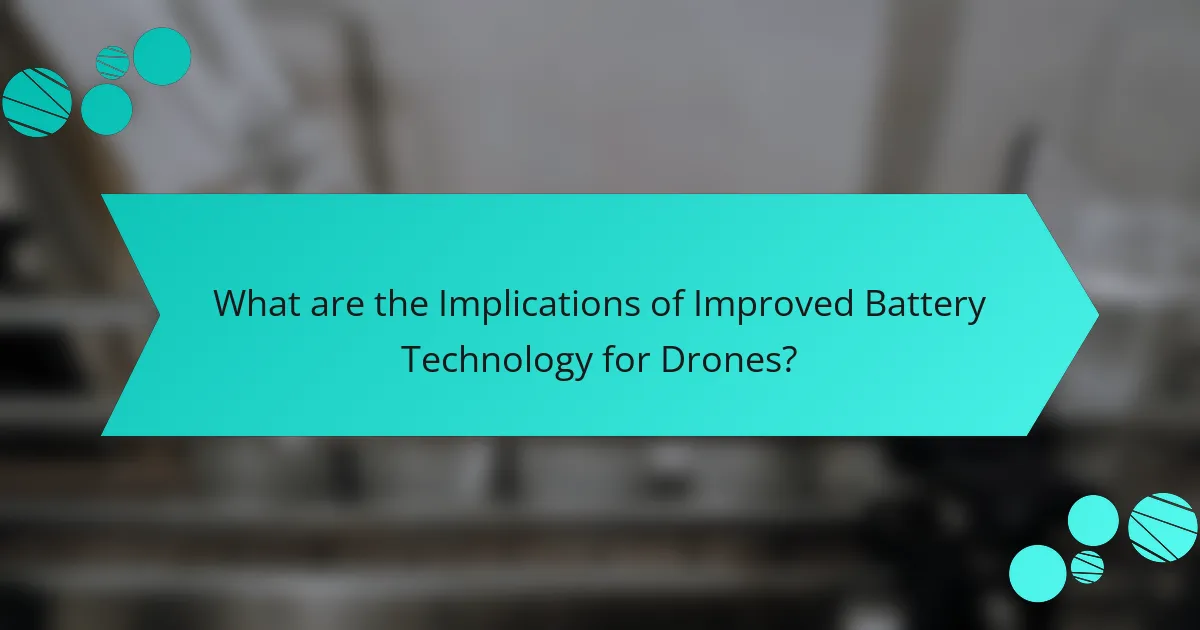
What are the Implications of Improved Battery Technology for Drones?
Improved battery technology significantly enhances drone performance. Longer battery life allows for extended flight times. This increase enables drones to cover larger areas in a single flight. Enhanced energy density leads to lighter batteries, improving overall drone efficiency. Faster charging times minimize downtime between operations. Advanced battery management systems improve safety and longevity. Enhanced power output allows drones to carry heavier payloads. These advancements are crucial for applications in delivery, surveillance, and agriculture.
How do advancements in battery technology affect drone applications?
Advancements in battery technology significantly enhance drone applications. Improved battery capacity extends flight times, allowing drones to operate longer without recharging. For instance, lithium-sulfur batteries can provide up to 500 Wh/kg, compared to traditional lithium-ion batteries at 150 Wh/kg. This increase in energy density enables drones to carry heavier payloads, such as advanced sensors or cameras. Enhanced charging speeds reduce downtime, facilitating quicker turnaround for commercial operations. Additionally, advancements in battery management systems improve safety and efficiency during operation. These innovations collectively expand the operational range and versatility of drones across various industries, including agriculture and logistics.
What industries stand to benefit from longer flight times?
Aviation, logistics, and agriculture industries stand to benefit from longer flight times. Aviation companies can enhance passenger experience with non-stop flights. Logistics firms can improve delivery efficiency over greater distances. Agriculture can utilize drones for extended crop monitoring and spraying. Each industry can leverage increased flight duration for operational advantages. For example, logistics companies like Amazon are already investing in drone technology for faster deliveries. Agricultural drones can cover larger areas, improving productivity and reducing labor costs.
How can improved battery technology enhance safety and reliability?
Improved battery technology enhances safety and reliability by reducing the risk of thermal runaway. Advanced materials and design minimize the chances of overheating. Enhanced battery management systems monitor temperature and charge levels in real-time. This proactive approach prevents overcharging and short circuits. Additionally, higher energy density allows for longer flight times. Longer flight times reduce the frequency of battery swaps, minimizing operational risks. Studies show that lithium-sulfur batteries can provide higher capacity and safety compared to traditional lithium-ion batteries. Overall, these advancements lead to more dependable drone operations.
What are the best practices for maximizing drone battery performance?
To maximize drone battery performance, follow these best practices. First, ensure batteries are charged correctly. Use the recommended charger and avoid overcharging. Second, maintain optimal temperature conditions. Batteries perform best between 20°C to 25°C. Third, avoid deep discharging. Keeping the battery between 20% and 80% charge prolongs its lifespan. Fourth, conduct regular maintenance. Clean battery contacts and check for damage. Fifth, store batteries properly. Keep them in a cool, dry place and avoid direct sunlight. Lastly, use energy-efficient flight modes. These modes can extend flight time by optimizing power usage. Following these practices can significantly enhance battery longevity and performance.
How can users extend the lifespan of drone batteries?
Users can extend the lifespan of drone batteries by following proper charging practices. Avoid overcharging the batteries, as this can lead to reduced capacity over time. Charge the batteries at the recommended voltage and current levels specified by the manufacturer. Store the batteries in a cool, dry place to prevent damage from heat or moisture. Regularly calibrate the battery to ensure accurate readings of remaining capacity. Use the battery regularly to keep it in good condition, as inactivity can lead to degradation. Finally, avoid deep discharging the battery, as this can significantly shorten its lifespan.
What maintenance tips should drone operators follow for optimal battery care?
Drone operators should follow specific maintenance tips for optimal battery care. Regularly check battery voltage and ensure it is within the recommended range. Avoid overcharging batteries, as it can reduce lifespan. Store batteries in a cool, dry place to prevent degradation. Use a storage charge of around 50% for long-term storage. Monitor battery temperature during use to prevent overheating. Clean battery contacts regularly to maintain good connections. Follow manufacturer guidelines for charging cycles to maximize battery health. These practices can significantly extend battery life and performance.
Flight time innovations in drone technology focus on advancements in battery technology that extend the operational duration of drones. Key developments include improvements in battery chemistries, such as lithium-sulfur and solid-state batteries, which offer higher energy densities and longer flight times. The article examines the impact of these innovations on drone performance, including the role of energy management systems and lightweight materials in optimizing power usage. Additionally, it discusses the challenges faced by current battery technologies and highlights the implications of improved battery performance across various applications, such as logistics and agriculture.
